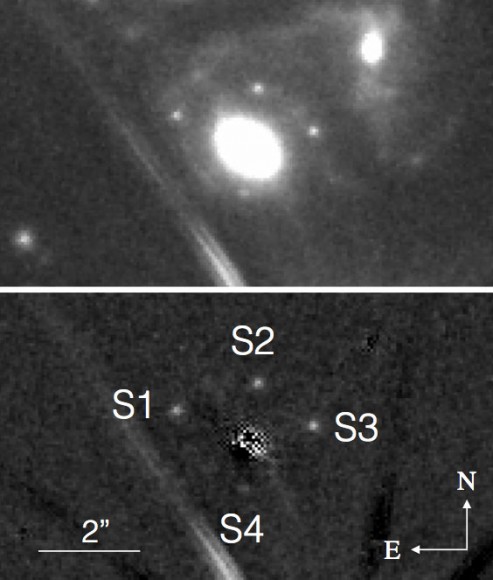| Online: | |
| Visits: | |
| Stories: |

| Story Views | |
| Now: | |
| Last Hour: | |
| Last 24 Hours: | |
| Total: | |
Astronomers Discover First Mulitiple-image Gravitationally-lensed Supernova

The four dots centered on the bright elliptical galaxy at top are multiple images of supernova SN Refsdal taken with the Hubble Space Telescope between November 10-20, 2014. In the bottom image, the galaxy has been digitally removed to show only the supernova images, labeled S1 through S4. The line segments are diffraction spikes from a nearby star. Credit: P.L. Kelly/GLASS/Hubble Frontier Fields
How about four supernovae for the price of one? Using the Hubble Space Telescope, Dr. Patrick Kelly of the University of California-Berkeley along with the GLASS (Grism Lens Amplified Survey from Space) and Hubble Frontier Fields teams, discovered a remote supernova lensed into four copies of itself by the powerful gravity of a foreground galaxy cluster. Dubbed SN Refsdal, the object was discovered in the rich galaxy cluster MACS J1149.6+2223 five billion light years from Earth in the constellation Leo. It’s the first multiply-lensed supernova every discovered and one of nature’s most exotic mirages.(…)
Read the rest of Astronomers Discover First Mulitiple-image Gravitationally-lensed Supernova (876 words)
© Bob King for Universe Today, 2014. |
Permalink |
No comment |
Post tags: Einstein’s Cross, galaxy cluster, Gravitational Lensing, gravity, MACS J1149.6+2223, Microlensing, SN Refsdal, spacetime, supernova
Feed enhanced by Better Feed from Ozh
Source: http://www.universetoday.com/116574/astronomers-discover-first-mulitiple-image-gravitationally-lensed-supernova/



